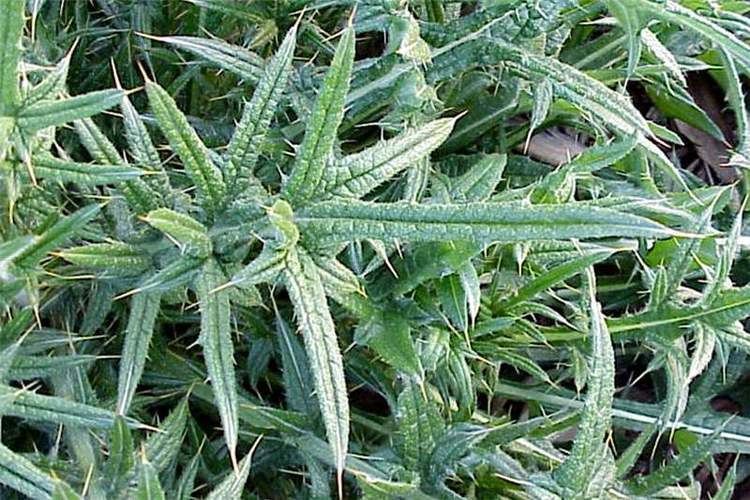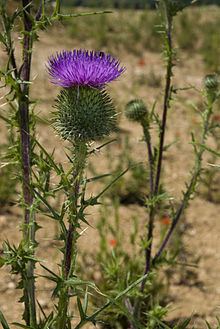Subfamily Carduoideae | Tribe Cynareae Scientific name Cirsium vulgare Rank Species | |
Similar Creeping Thistle, Sow thistles, Prickly Lettuce, Cat's ear, Curly Dock | ||
Cirsium vulgare (spear thistle, bull thistle, or common thistle) is a species of the genus Cirsium, native throughout most of Europe (north to 66°N, locally 68°N), Western Asia (east to the Yenisei Valley), and northwestern Africa (Atlas Mountains). It is also naturalised in North America, Africa, and Australia and is an invasive weed in some areas. It is the national flower of Scotland.
Contents

Description

It is a tall biennial or short-lived monocarpic thistle, forming a rosette of leaves and a taproot up to 70 cm long in the first year, and a flowering stem 1–1.5 m tall in the second (rarely third or fourth) year. The stem is winged, with numerous longitudinal spine-tipped wings along its full length. The leaves are stoutly spined, grey-green, deeply lobed; the basal leaves up to 15–25 cm long, with smaller leaves on the upper part of the flower stem; the leaf lobes are spear-shaped (from which the English name derives). The inflorescence is 2.5–5 cm diameter, pink-purple, with all the florets of similar form (no division into disc and ray florets). The seeds are 5 mm long, with a downy pappus, which assists in wind dispersal. As in other species of Cirsium (but unlike species in the related genus Carduus), the pappus hairs are feathery with fine side hairs.
Ecology

Spear thistle is often a ruderal species, colonising bare disturbed ground, but also persists well on heavily grazed land as it is unpalatable to most grazing animals. Nitrogen-rich soils help increase its proliferation. The flowers are a rich nectar source used by numerous pollinating insects, including honey bees, wool-carder bees, and many butterflies. The seeds are eaten by goldfinches, linnets and greenfinches. The seeds are dispersed by wind, mud, water, and possibly also by ants; they do not show significant long-term dormancy, most germinating soon after dispersal and only a few lasting up to four years in the soil seed bank. Seed is also often spread by human activity such as hay bales.
Cirsium vulgare as a weed
Spear thistle is designated an "injurious weed" under the UK Weeds Act 1959, and a noxious weed in Australia and in nine US states. Spread is only by seed, not by root fragments as in the related creeping thistle C. arvense. It is best cleared from land by hoeing and deep cutting of the taproot before seeds mature; regular cultivation also prevents its establishment.
Other names
Other English names include bull thistle, Scots, Scottish, or Scotch thistle, and common thistle.
Uses
The stems can be peeled and then steamed or boiled. The tap roots can be eaten raw or cooked, but are only palatable on young thistles that have not flowered yet.
